My mouth waters every time I think about Yuca En Escabeche, a traditional Puerto Rican pickled cassava dish that’s as delicious and vibrant as it is versatile. It’s a bit like a punchy vinegar-based potato salad but with olives, onions, and yuca. It holds exceptionally well and makes a perfect appetizer or side for a backyard BBQ or beach picnic.
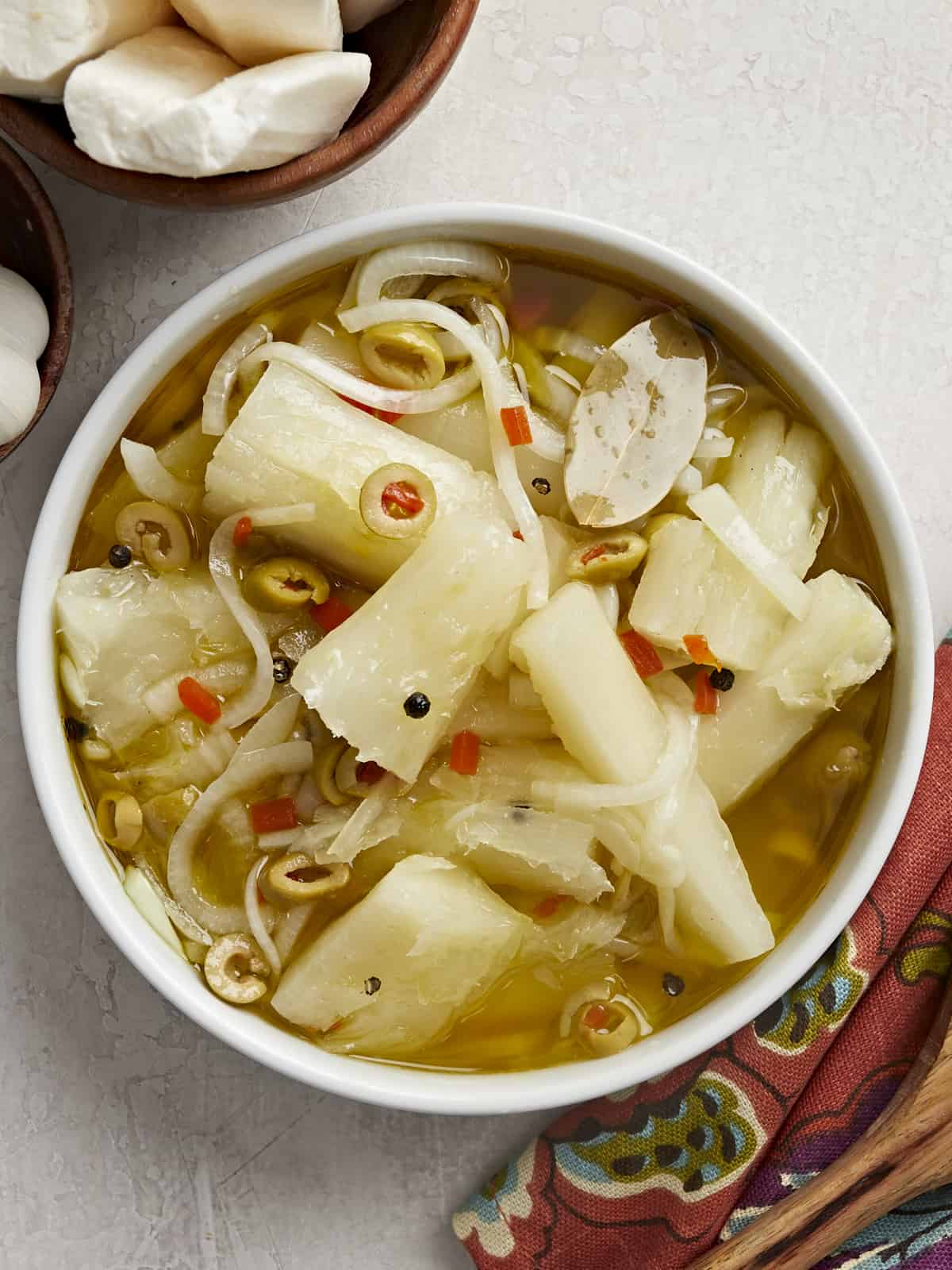
All recipes are rigorously tested in our Nashville Test Kitchen to ensure they are easy, affordable, and delicious.
What is Yuca?
Yuca is a root vegetable like potato or taro. It is shaped like a large yam with a dark brown bark-like exterior and bright white flesh. It has a woody core that looks like a white root running through the middle of it lengthwise. You can find yuca fresh, frozen, and canned in most Latin grocery stores. It’s also often stocked in the freezer section at mainstream grocers.
What Is Escabeche?
Escabeche is a preserving technique that’s very popular all over Latin America. You warm a simple mix of oil and vinegar with a few aromatics and use it to pickle cooked vegetables, fruits (like green bananas), or fish. Because of the high acidity of the sauce, the pickled food stays fresh for a week, developing deeper flavors as it ages. Yuca En Escabeche is boiled cassava root smothered in escabeche sauce and served hot, cold, or at room temperature.
Ingredients
Get ready for your new summer favorite! It’s cooling on a hot day, comes together in just a few minutes, and you can easily double, triple, or quadruple the recipe. It’s one of those dishes I’ll make a big batch of and eat nonstop, paired with absolutely everything until it’s all gone. Here’s what you need to make Yuca En Escabeche:
- Yuca– You can purchase yuca fresh or frozen. Fresh requires a lot of prep as you must peel off its woody bark and quarter it to remove the woody core. Frozen is my preference, as it’s already peeled and chopped. However, you should thaw it and make sure the woody core is removed, as sometimes it isn’t. Canned yuca is already prepped and cooked. You can simply drain it and add it to the escabeche sauce.
- Olive Oil and Distilled White Vinegar– are the base of the escabeche sauce. Use an olive oil that has a flavor you enjoy. Though distilled vinegar is traditional, feel free to use apple cider vinegar or rice wine vinegar. This recipe is a 2 to 1 ratio of oil to vinegar. If you want something less acidic, use a 3 to 1 ratio. I prefer an aggressively acidic escabeche and use a 1 to 1 ratio of oil to vinegar. You do you!
- Bay Leaves, Peppercorns, Salt, and Adobo – these spices add much-needed complexity to the simple escabeche sauce. If you don’t have adobo, omit it and up your salt game by a 1/4 teaspoon. Also add 1/4 teaspoon of garlic powder, 1/4 teaspoon of onion powder, and 1/4 teaspoon of ground cumin. Bay leaves are a must for me, but try subbing them with a pinch or two of dry oregano if you’re out.
- Onions and Garlic– are an integral part of the escabeche. They add deep earthy flavors and texture to the dish. You can substitute yellow onion with white or red onion. Sometimes garlic will turn a blue-green color when exposed to a highly acidic sauce. Don’t fret. It isn’t mold. If blueish-hued garlic slices make you uncomfortable, remove them.
- Spanish Olives and Olive Brine – these roasted red pepper-stuffed olives (AKA Manzanilla or green olives) add a pop of tart and fruity notes to the dish, while their brine rounds out the acidity of the escabeche and creates complexity.
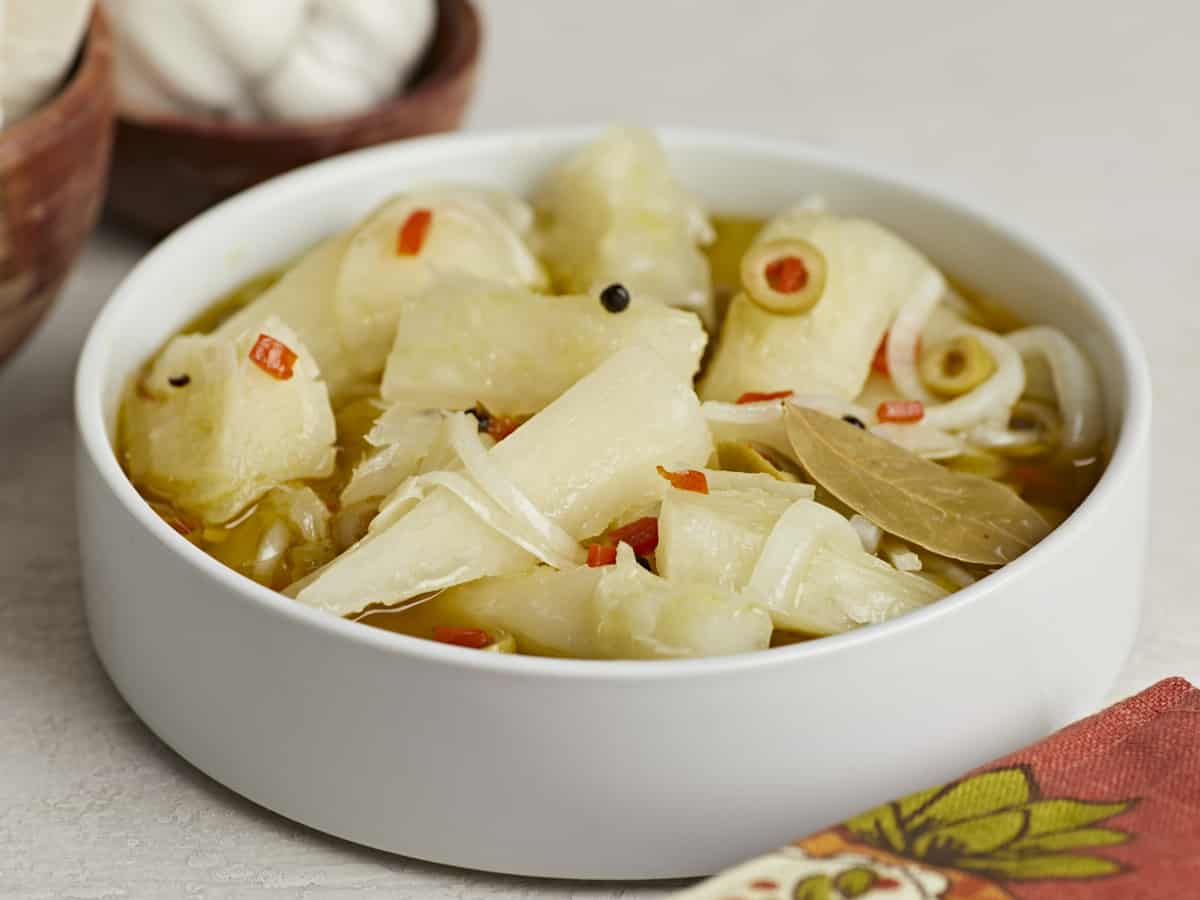
Variations on Yuca en Escabeche
Make this dish your own with additional veggies, spices, and proteins.
- Strips of roasted red pepper make a beautiful and tasty addition. So do thin slices of fresh green and red bell peppers.
- Mix different kinds of vinegar to add complexity. Just makes sure to use white or light-colored vinegar to preserve the color of the yuca.
- Make a heartier version by topping the yuca with slices of hard-boiled egg, cooked shrimp, or chopped chicken.
- Add different vegetables, such as chopped zucchini, squash, or tomatoes. Though not traditional choices, they are delicious.
- Try using different spices, such as cumin, oregano, or cilantro.
What Do I Serve With Yuca En Escabeche?
This dish is excellent on its own, but I love it even more as a side. I pair it with Roasted Chicken, Chuletas Guisadas, or Puerto Rican Rice and Beans.
How To Store Leftovers
Store the yuca in an airtight container with plastic film over the surface. If at all possible, use a glass container, as the vinegar and garlic odors will cling to plastic. Refrigerate for up to a week. Freeze for up to 3 months. When ready to serve, thaw frozen yuca overnight in the fridge. Yuca can be served cold or at room temperature. If you prefer to serve it hot, warm it in a microwave until steaming.
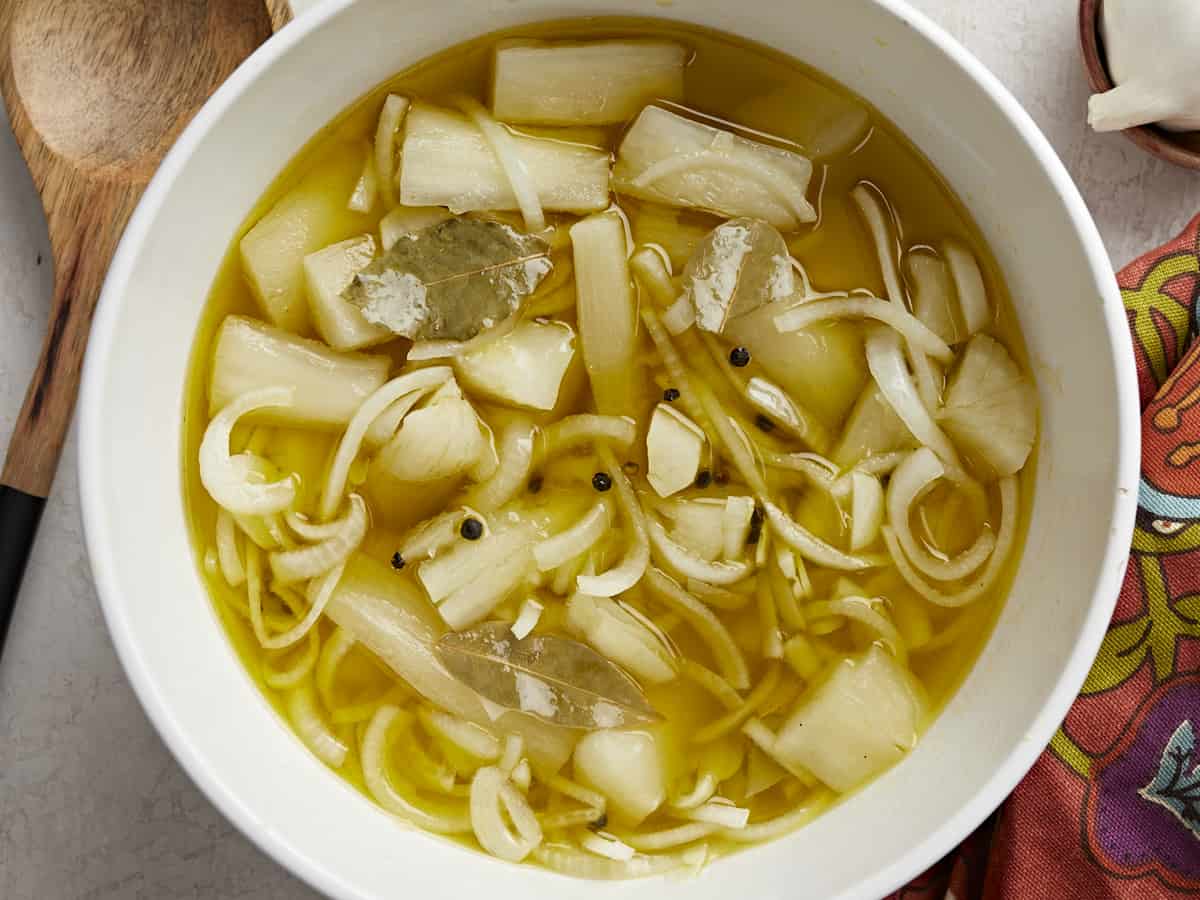
Yuca En Escabeche
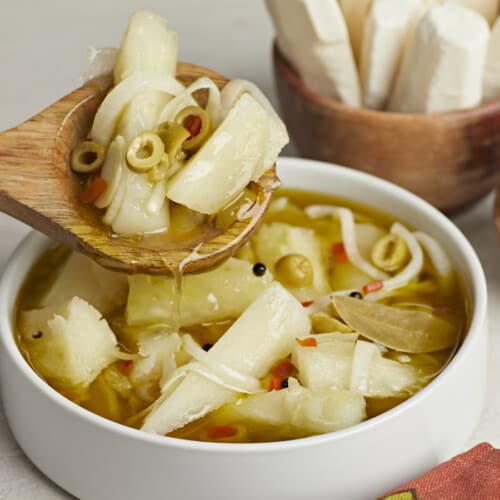
Ingredients
- 1 lb yuca (fresh or frozen) ($1.55)
- 4 tsp kosher salt, divided ($0.16)
- 2/3 cup olive oil ($0.84)
- 1/3 cup distilled white vinegar ($0.41)
- 3 bay leaves ($0.30)
- 1/2 tsp black peppercorns ($0.05)
- 1 tsp adobo seasoning ($0.04)
- 1 yellow onion, sliced in half moons ($0.42)
- 8 cloves garlic, thinly sliced ($0.34)
- 1/4 cup sliced Spanish olives (AKA Manzanilla olives ) ($0.33)
- 1/8 cup olive brine ($0.09)
Instructions
- If the yuca is fresh, peel and split it into 4-inch long quarters. Remove the woody center root. If the yuca is frozen, split it into 4-inch halves. Make sure the woody center has been removed and then cut each half in half.
- Add yuca to a Dutch oven or other large heavy-bottomed pot. Add water until you cover the yuca by two inches. Add 2 teaspoons of salt. Boil until the yuca is fork-tender but not mushy, about 25 to 30 minutes. Then drain the yuca and cool.
- While the yuca cooks, set a small pot over medium-low heat. Add the olive oil and warm. Add the vinegar, peppercorns, bay leaf, remaining 2 teaspoons salt, adobo, onions, garlic, olives, and olive brine to the warm oil. Cook for 10 minutes, stirring occasionally, then remove from the heat.
- Add the yuca to a large bowl. Cover the drained yuca with escabeche. Let it sit at room temperature for at least 30 minutes to develop the flavors, then serve.
See how we calculate recipe costs here.
Nutrition
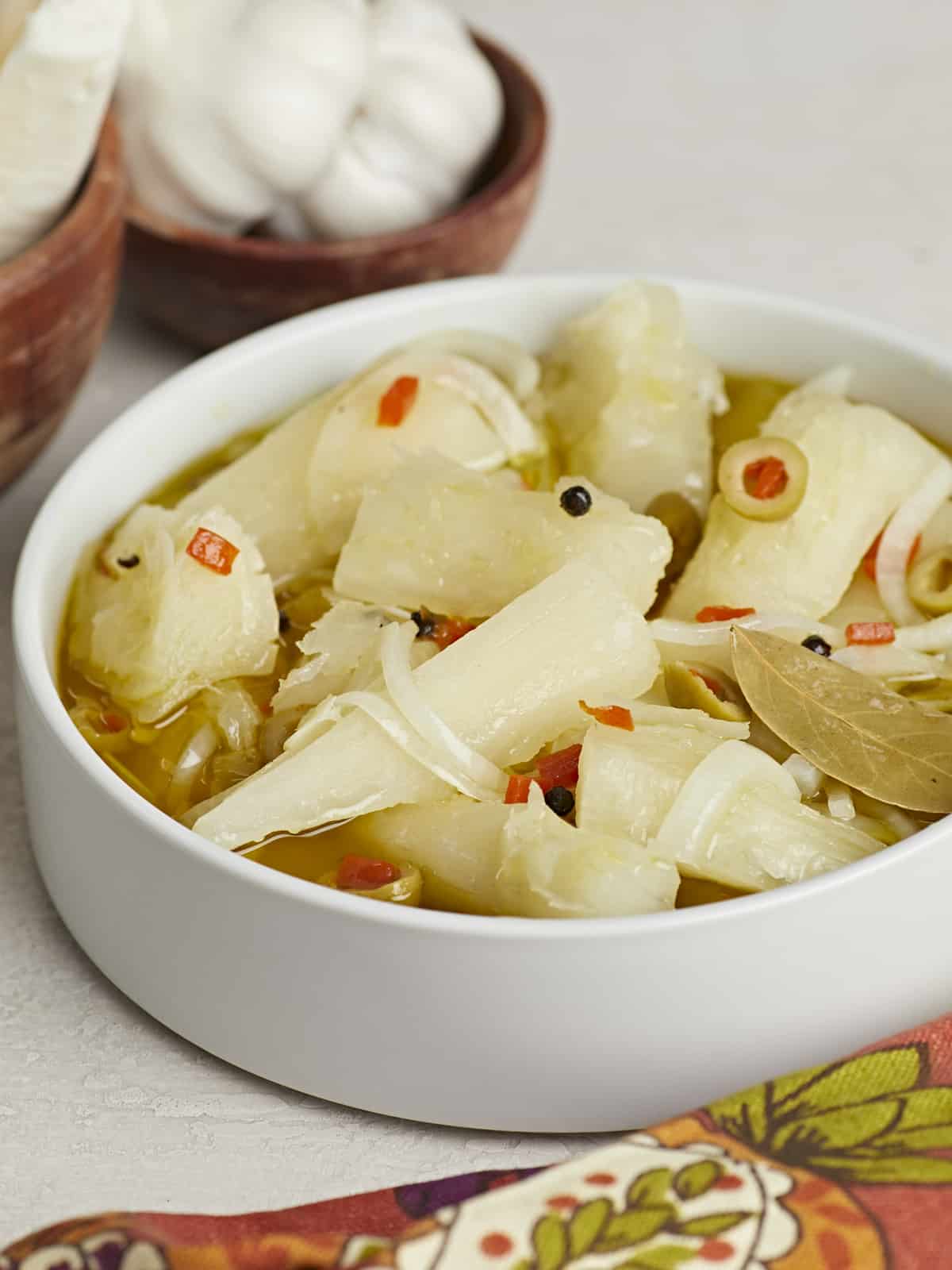
How to Make Yuca En Escabeche – Step by Step Photos
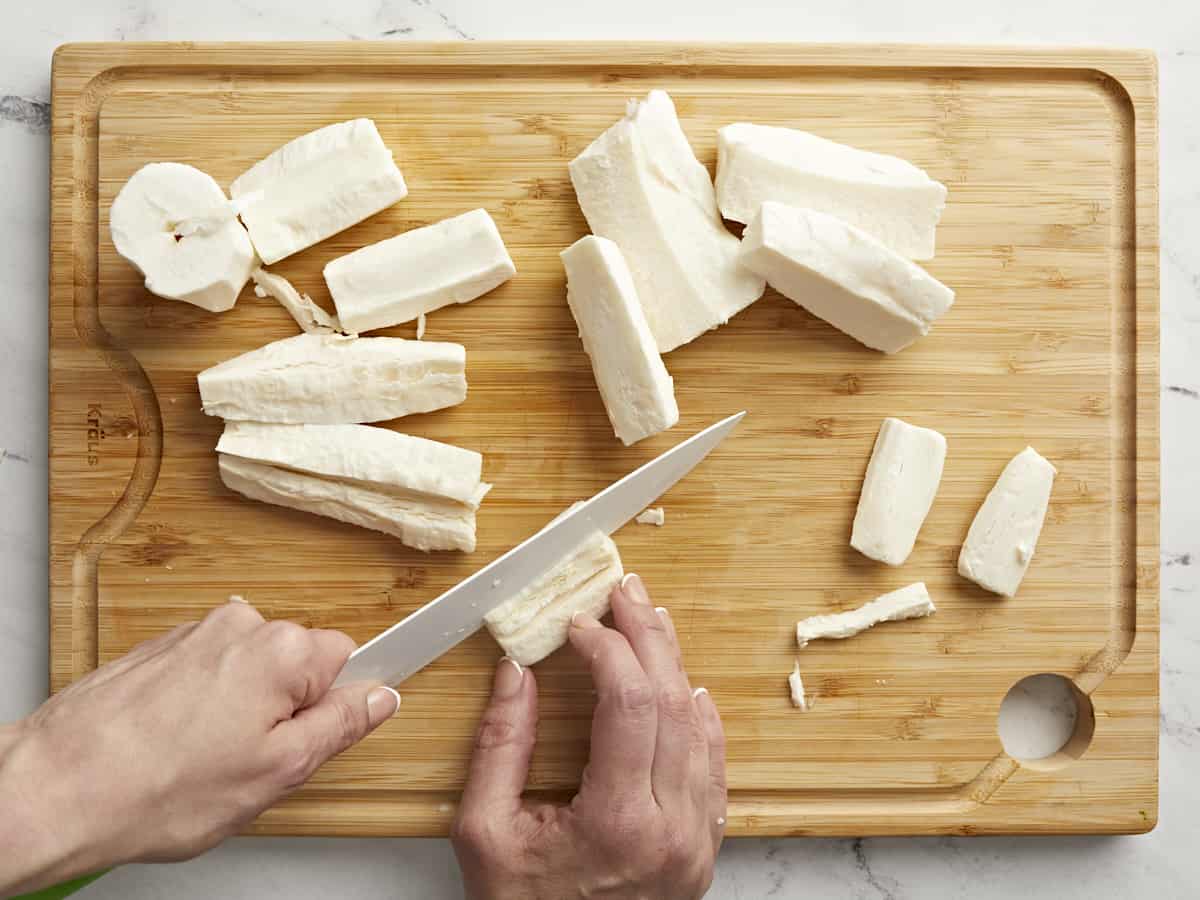
Prepare 1 pound of yuca. If the yuca is fresh, peel and split it into 4-inch long quarters. Remove the woody center root. If the yuca is frozen, split it into 4-inch halves. Make sure the woody center has been removed and then cut each half in half.
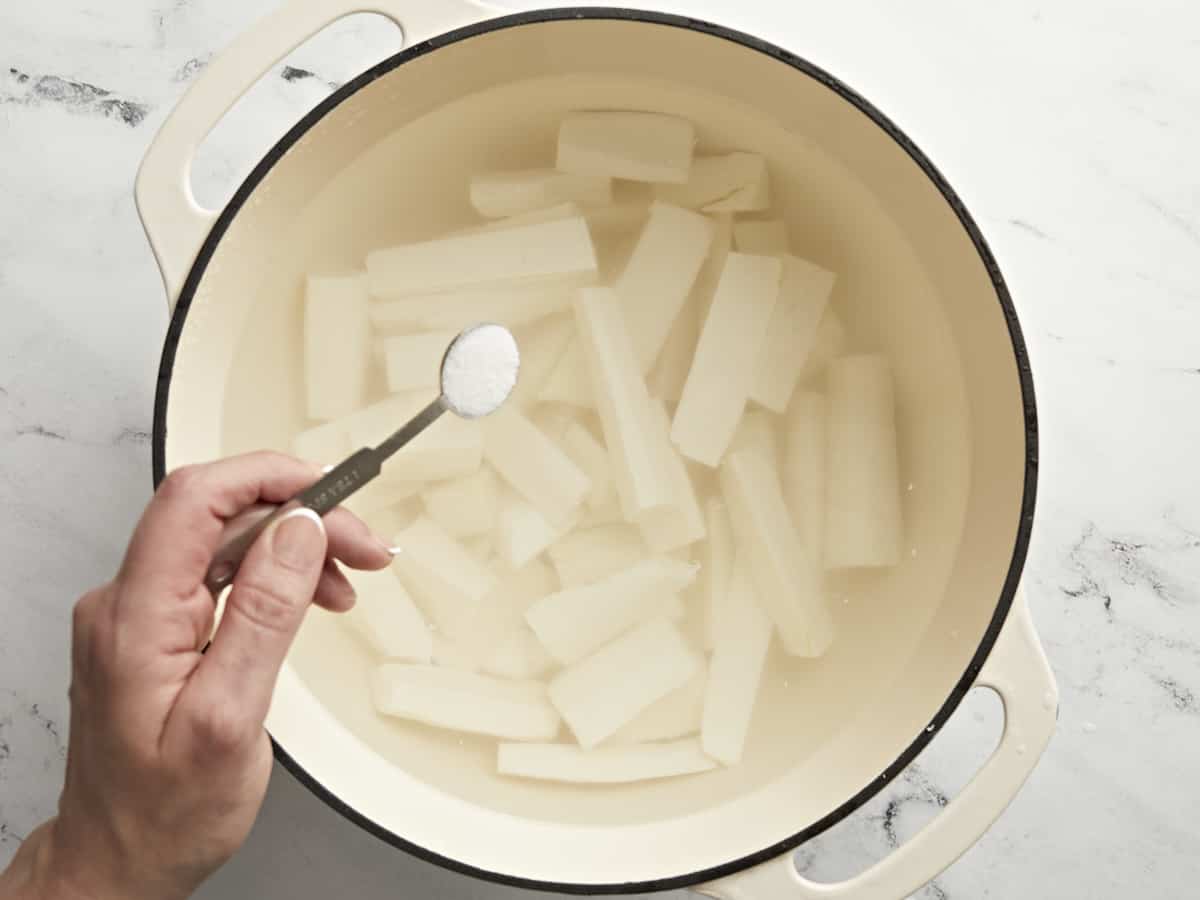
Add the yuca to a Dutch oven or other large heavy-bottomed pot. Add water until you cover the yuca by two inches. Add 2 teaspoons of salt. Boil until the yuca is fork-tender but not mushy, about 25 to 30 minutes. Then drain the yuca and cool.
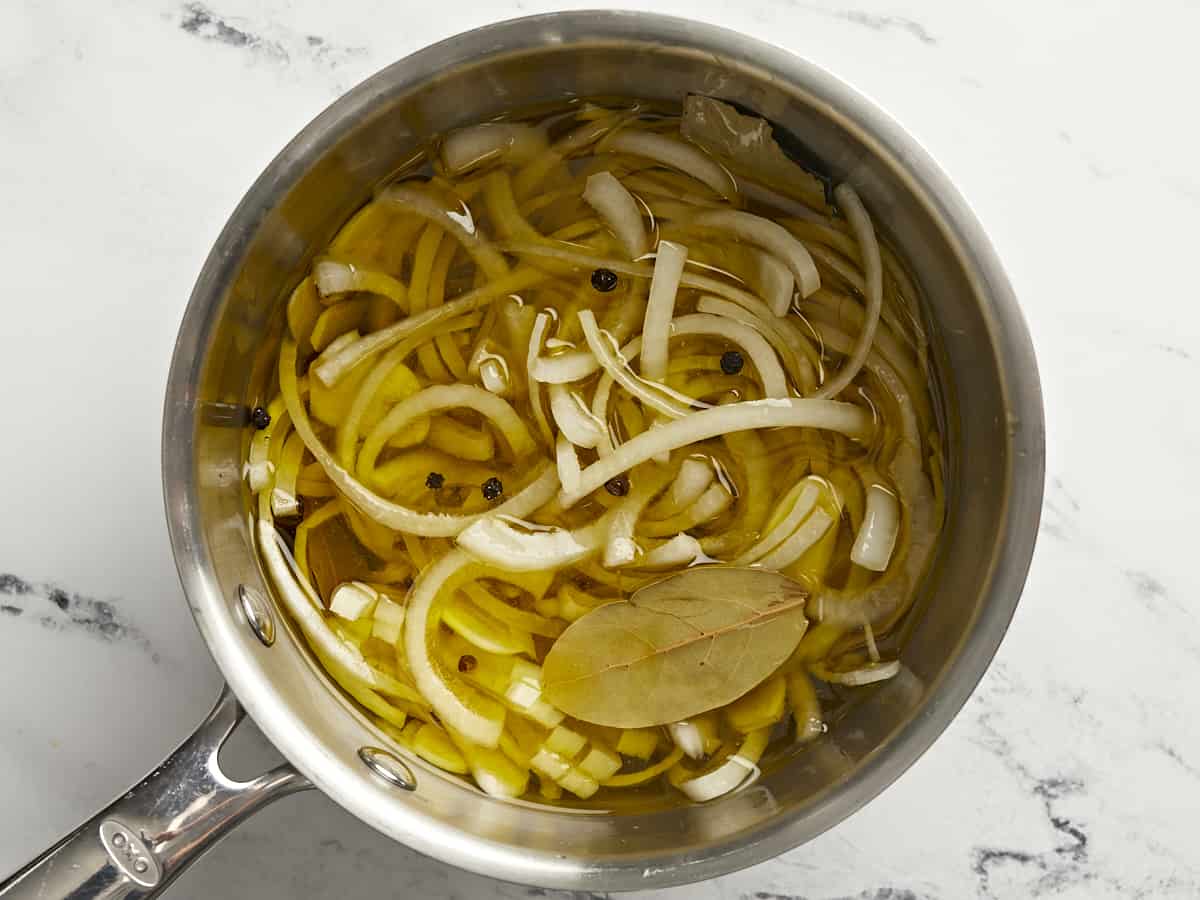
While the yuca cooks set a small stainless steel or enameled pot over medium-low heat. Avoid aluminum pots as highly acidic ingredients, like vinegar, can cause aluminum to leach into food, which leaves the food with a metallic taste. Add 2/3 cup of olive oil and warm. You don’t want the oil hot, just warm. Add the 1/3 cup of vinegar, 1/2 teaspoon peppercorns, 3 bay leaves, remaining 2 teaspoons salt, 1 teaspoon adobo, 1 medium onion sliced in half moons, 8 thinly sliced garlic cloves, 1/4 cup Spanish olives, and 1/8 cup of olive brine to the warm oil. Cook for 10 minutes, stirring occasionally. The onions should remain white but will wilt. Once wilted, remove from the heat.
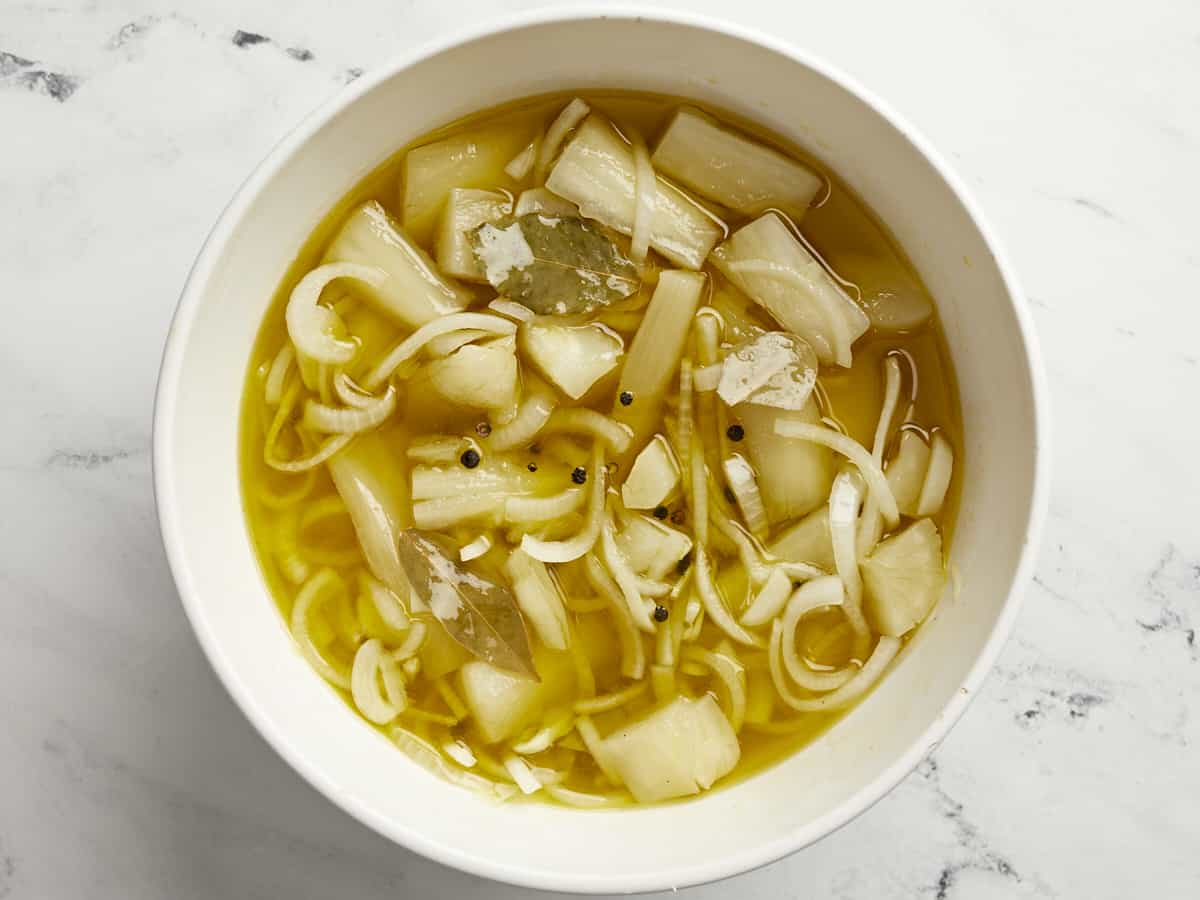
Add the boiled yuca to a large boil and cover with the warm escabeche sauce. Allow the yuca to pickle for a minimum of 30 minutes before serving. To develop deeper flavors, cover the bowl with plastic wrap directly on the surface of the yuca and refrigerate overnight. Serve cold, at room temperature, or heat in a microwave until steaming. Enjoy this incredible dish as is or serve it with Roasted Chicken, Chuletas Guisadas, or Puerto Rican Rice and Beans!



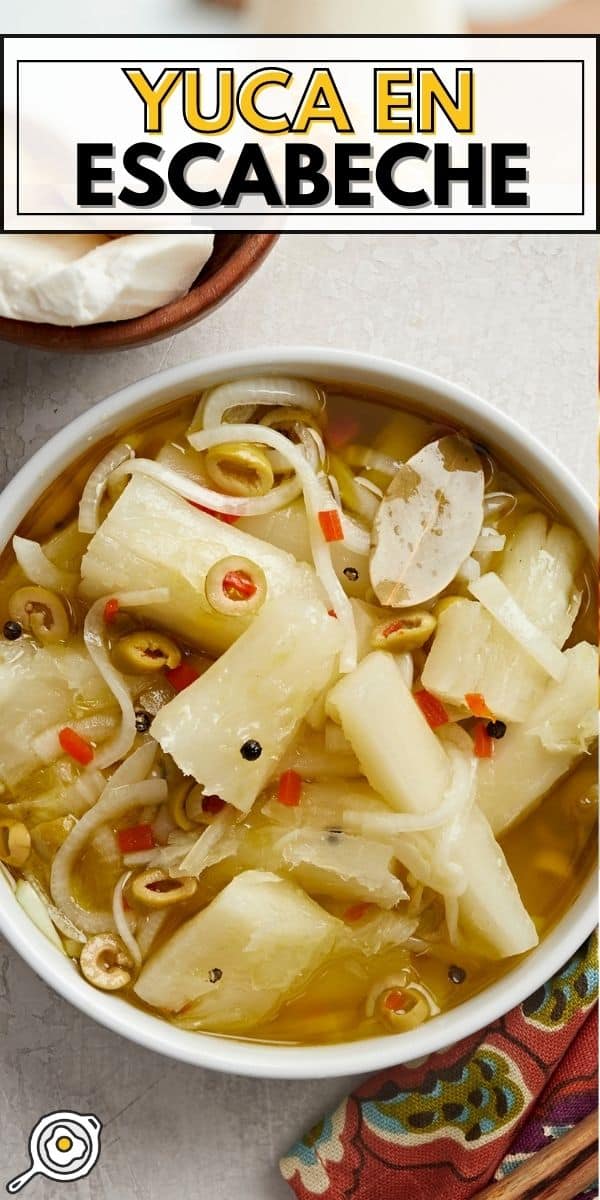
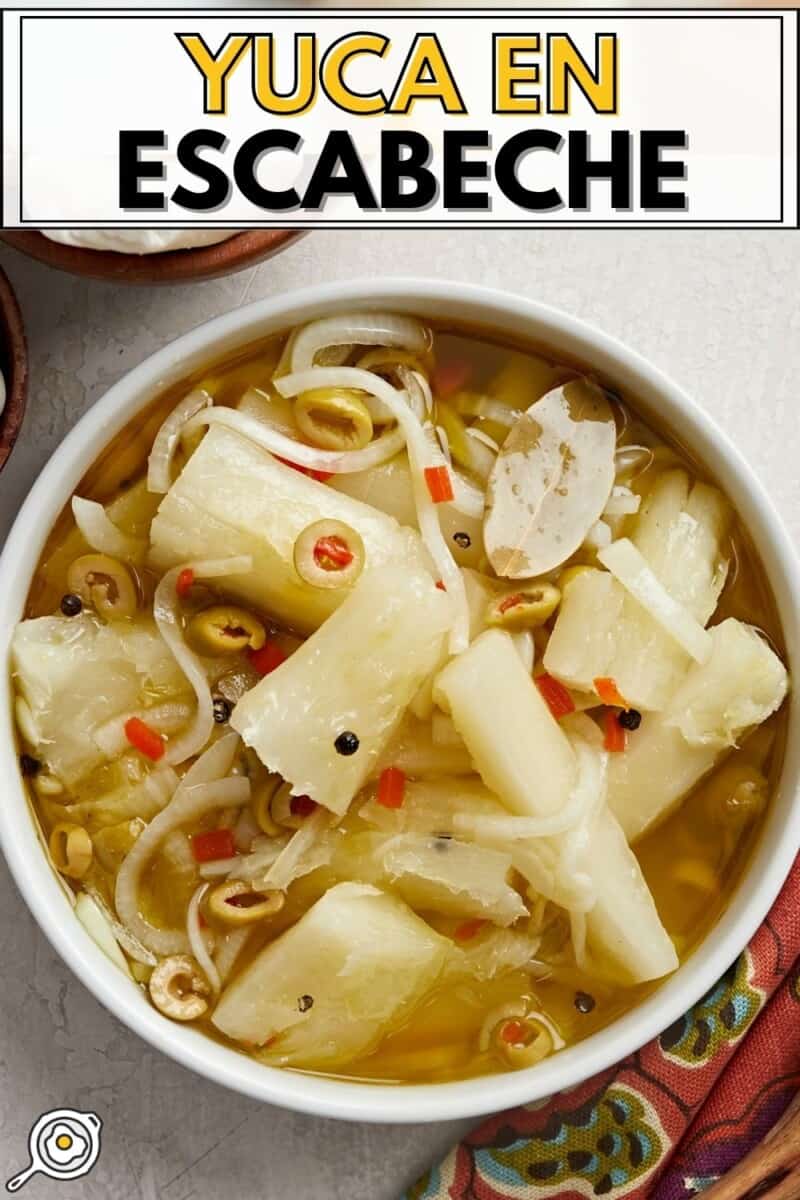
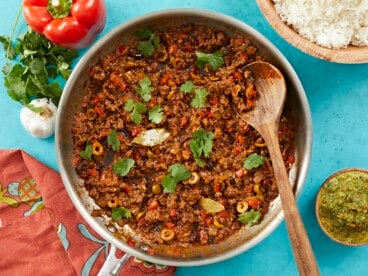
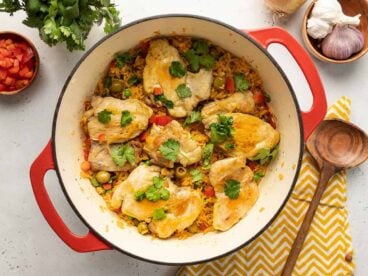
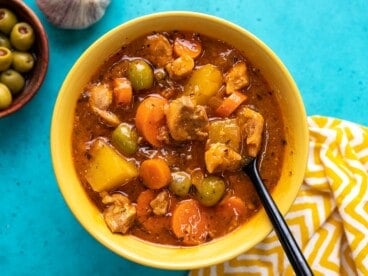
Very tasty!!
I had this in Puerto Rico (without realizing what it was called) and absolutely loved it. Can’t wait to try this recipe, it looks super simple!
Thanks, JD!
Wepa!~ Gracia Monti!
Wepa, Boricua!! xoxo